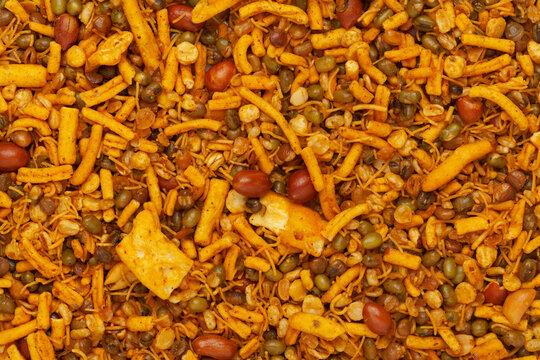Process for making verity namkeen and snack:The process for making namkeen (savory snacks) can vary depending on the type of namkeen you’re producing. Here’s a general process that covers common varieties like sev, bhujia, chivda, and mixtures. This process includes the main steps involved in a typical namkeen production cycle.

Table of Contents
1. Ingredient Preparation
RAW Material: .Gram Flour
.Rice Powder
.Refined Oil
. Salt
.yellow Colour
.Sugar Powder
.Chili Powder
. Asafoetida (Hing water)
.Baking Soda
.Black Salt
.kaju
.Penaut
.khismis
.Black cumin seeds
.ajwain
Spice Item. . Cinnamon powder
. Cumin Powder
.Kurkuri masala
. Black cardamom
.Nutmeg
.Mace
.Star Anise
. Cloves
.Curry leaf
- Preparation Process:
- 1st step:
- Gram flour (5kg)and Rice powder(1kg) mixed it well then pour out on gram flour mixing machine then pour out Refined oil 2Liter then add some kala jeera then add hengu mixed water then add baking soda then give water in its requirement then start machine till mixed well ,then make sure the dough is not too soft not too hard.for this process use gram flour mixing machine or in hand manual process.
- After preparation of gram flour mixing :
2nd step:Heat the Oil: Use a suitable oil like sunflower oil, peanut oil, or palm oil, and heat it to the right temperature (usually around 160-180°C or 320-350°F). Avoid overheating to prevent burning the namkeen. For heat the oil use electric or gas or koila.
3rd step:
For shaped namkeen varieties (like sev, gathiya, paturi ,or bhujia) ,use mold in namkeen making machine or manual press mold.throw the dough in the namkeen making machine or press the dough on the mold(if manual mold).Then Fry until golden brown and crispy.Additional Ingredients: If making mixtures, you’ll need additional ingredients like peanuts, puffed rice, or roasted chana,spilt chickpeas.
4th step:
Oil Drainage: Once fried, remove the namkeen from the oil and place it on absorbent paper or a sieve to drain excess oil then for clear dry or reduce oil from nakeen use oil dry machine.
5th step:
Cooling:
Allow the fried namkeen to cool to room temperature before adding any seasonings. This prevents spices from clumping and ensures an even coating.
6th step:
Mixed spice: make the powder of whole spice(gota masala)
Give the the red chilli, black salt ,then give sugar powder,chat masala or kurkuri masala , add fried curry leaf on namkeen then mixed it through masala mixing machine or manually.
7th step:
Packing
Batching and Sealing: Measure the namkeen into standard-sized packets (e.g., 100g, 250g, 500g) and seal immediately to preserve freshness.
Labeling: Include all necessary labeling, such as ingredients, nutritional facts, batch number, manufacturing, and expiry date.
Pouch packing: Make the designed pouch for compition market from pouch making factory .
For split chickpeas(chana dal) mixture: soak the seak peice or chana in water for 7 to 8 hour then after dry the water from it and fry it in oil in required oil.then fry peanuts and then make all ingredients which require for it .and prepare like namkeen process.
U can make peanut fry( badam pakoda) using gram flour,corn flour,garam masala,salt , haldi powder mixed it then fried it in oil .
U can make chuda mixture using this type of process.
U can make all type of snack item in this way.
Quality Control
Taste Test: Test for flavor, texture, and consistency to ensure the batch meets quality standards.
Visual Inspection: Check that the color, shape, and size are consistent with product standards.
Remove Excess Oil: If needed, use an oil filter or blot the namkeen to reduce oiliness, ensuring it’s crisp and dry.
9. Storage and Distribution
Storage: Store finished packages in a cool, dry place, away from direct sunlight to avoid spoilage.
Distribution: Distribute the packaged namkeen to whole sale, retail stores, supermarkets, or directly to customers, based on your sales strategy.
Key Points to Remember:
Temperature Control: Always maintain consistent frying temperatures to avoid oil degradation and ensure a crisp texture.
Hygiene: Follow strict hygiene standards in each step to ensure food safety.
Quality Ingredients: Use fresh, high-quality ingredients and oil for the best flavor and a longer shelf life.
By following this process, you can produce a wide variety of high-quality namkeen with consistent flavor, texture, and shelf life.